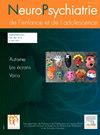La consommation de médicaments psychotropes chez les enfants et les adolescents autistes en France. Analyse des bases du Système national de données de santé sur la période 2010–2022
Q4 Medicine
Neuropsychiatrie de l''Enfance et de l''Adolescence
Pub Date : 2025-06-01
DOI:10.1016/j.neurenf.2025.02.006
引用次数: 0
Abstract
Context
Questions regarding the use of psychotropic medications in children and adolescents with autism have drawn significant attention in the scientific literature and public debates at the international level. However, to date, no dedicated epidemiological data are available on this topic in the scientific literature or in information provided by health agencies or public authorities in France. This article aims to analyze data from the National Health Data System (SNDS) to describe trends in psychotropic medication use among children and adolescents with autism between 2010 and 2022, as well as the clinical, demographic, and social factors contributing to these prescriptions.
Methods
A systematic analysis was conducted on psychotropic medication use in autistic patients aged 0 to 17 years within the SNDS database (covering 99% of the population residing in France) from 2010 to 2022. The study focused on the following classes of medications: N05A antipsychotics, N05B anxiolytics, N05 C hypnotics and sedatives, N06A antidepressants, N06B psychostimulants, N03 antiepileptics, and N04 antiparkinsonians.
Results
Analysis of the SNDS data revealed a high rate of psychotropic medication use among children and adolescents with autism: 36.8% in 2022, including 26.3% among 0–2-year-olds, 27.8% among 3–5-year-olds, 36.5% among 6–11-year-olds, and 41.7% among 12–17-year-olds. The use of psychotropic medications in autistic patients aged 0 to 17 years remained stable between 2010 (31.8%) and 2019 (31.6%) but increased from 2019 to 2022 (36.8%). However, disparities are observed across treatment subclasses: a decrease in antiepileptics (N03A) (7.5% in 2010 to 3.9% in 2022), antiparkinsonians (N04A) (2.2% in 2010 to 1.2% in 2022), antipsychotics (N05A) (18.6% in 2010 to 16.1% in 2022), and anxiolytics (N05B) (10.2% in 2010 to 8.3% in 2022); and an increase in hypnotics (N05C) (0.7% in 2010 to 15.4% in 2022), antidepressants (N06A) (2.5% in 2010 to 3.8% in 2022), and psychostimulants (N06B) (6.3% in 2010 to 11.9% in 2022). These prescription rates are accompanied by significant consumption volumes, with an average of 18 to 19 boxes per year per child and treatment durations exceeding 10 years. Polypharmacy is prevalent, and associated biological monitoring is insufficient. The social disadvantage rate within this population was 43.5% in 2022.
Discussion
The findings are discussed in light of international scientific consensus, recommendations from health agencies, and contemporary initiatives focusing on deprescription practices in autism care for children and adolescents. Further research is needed to explore the potential adverse effects of these medications, the clinical reasons for their prescriptions, and the most suitable therapeutic strategies for autistic children.
法国自闭症儿童和青少年使用精神药物的情况。2010 - 2022年国家卫生数据系统数据库分析
关于自闭症儿童和青少年使用精神药物的问题在科学文献和国际层面的公开辩论中引起了极大的关注。然而,迄今为止,在科学文献或法国卫生机构或公共当局提供的信息中,没有关于这一主题的专门流行病学数据。本文旨在分析来自国家卫生数据系统(SNDS)的数据,以描述2010年至2022年间自闭症儿童和青少年使用精神药物的趋势,以及导致这些处方的临床、人口和社会因素。方法系统分析2010 - 2022年SNDS数据库(覆盖法国99%的居住人口)中0 ~ 17岁自闭症患者的精神药物使用情况。研究集中在以下几类药物:N05A抗精神病药、N05B抗焦虑药、n05c催眠药和镇静剂、N06A抗抑郁药、N06B精神兴奋剂、N03抗癫痫药和N04抗帕金森药。结果对SNDS数据的分析显示,儿童和青少年自闭症患者的精神药物使用率较高:2022年为36.8%,其中0 - 2岁26.3%,3 - 5岁27.8%,6 - 11岁36.5%,12 - 17岁41.7%。2010年(31.8%)至2019年(31.6%),0 - 17岁自闭症患者使用精神药物的情况保持稳定,但2019年至2022年(36.8%)有所增加。然而,在治疗亚类中观察到差异:抗癫痫药(N03A)(2010年为7.5%,2022年为3.9%)、抗帕金森药(N04A)(2010年为2.2%,2022年为1.2%)、抗精神病药(N05A)(2010年为18.6%,2022年为16.1%)和抗焦虑药(N05B)(2010年为10.2%,2022年为8.3%)下降;催眠药(N05C)从2010年的0.7%增加到2022年的15.4%,抗抑郁药(N06A)从2010年的2.5%增加到2022年的3.8%,精神兴奋剂(N06B)从2010年的6.3%增加到2022年的11.9%。这些处方率伴随着巨大的消费量,平均每个儿童每年18至19盒,治疗持续时间超过10年。多药是普遍的,相关的生物监测是不足的。2022年,这一人口中的社会劣势率为43.5%。根据国际科学共识、卫生机构的建议以及关注儿童和青少年自闭症护理中去处方做法的当代倡议,对研究结果进行了讨论。需要进一步的研究来探索这些药物的潜在不良反应,处方的临床原因,以及最适合自闭症儿童的治疗策略。
本文章由计算机程序翻译,如有差异,请以英文原文为准。
求助全文
约1分钟内获得全文
求助全文
来源期刊

Neuropsychiatrie de l''Enfance et de l''Adolescence
Medicine-Pediatrics, Perinatology and Child Health
CiteScore
0.60
自引率
0.00%
发文量
61
期刊介绍:
Organ of the Société française de psychiatrie de enfant et de adolescent, Neuropsychiatrie de enfance et de adolescence tackles all fields of child-adolescent psychiatry and offers a link between field and clinical work. As a reference and training tool for students and practitioners, the journal publishes original papers in child psychiatry as well as book reviews and conference reports. Each issue also offers a calendar of the main events dealing with the speciality.
 求助内容:
求助内容: 应助结果提醒方式:
应助结果提醒方式:


